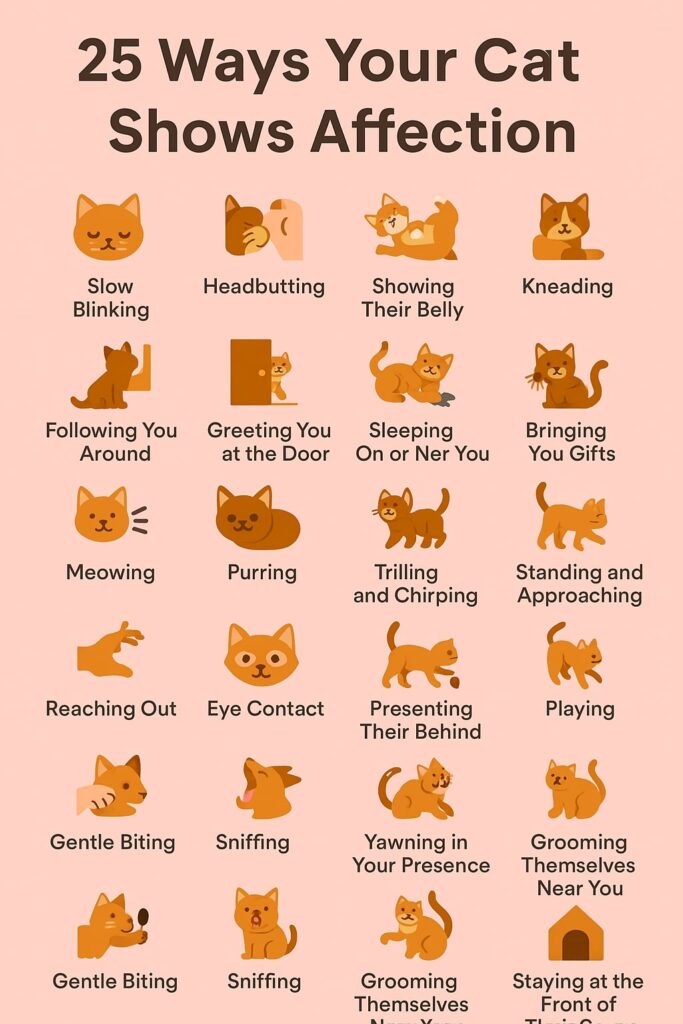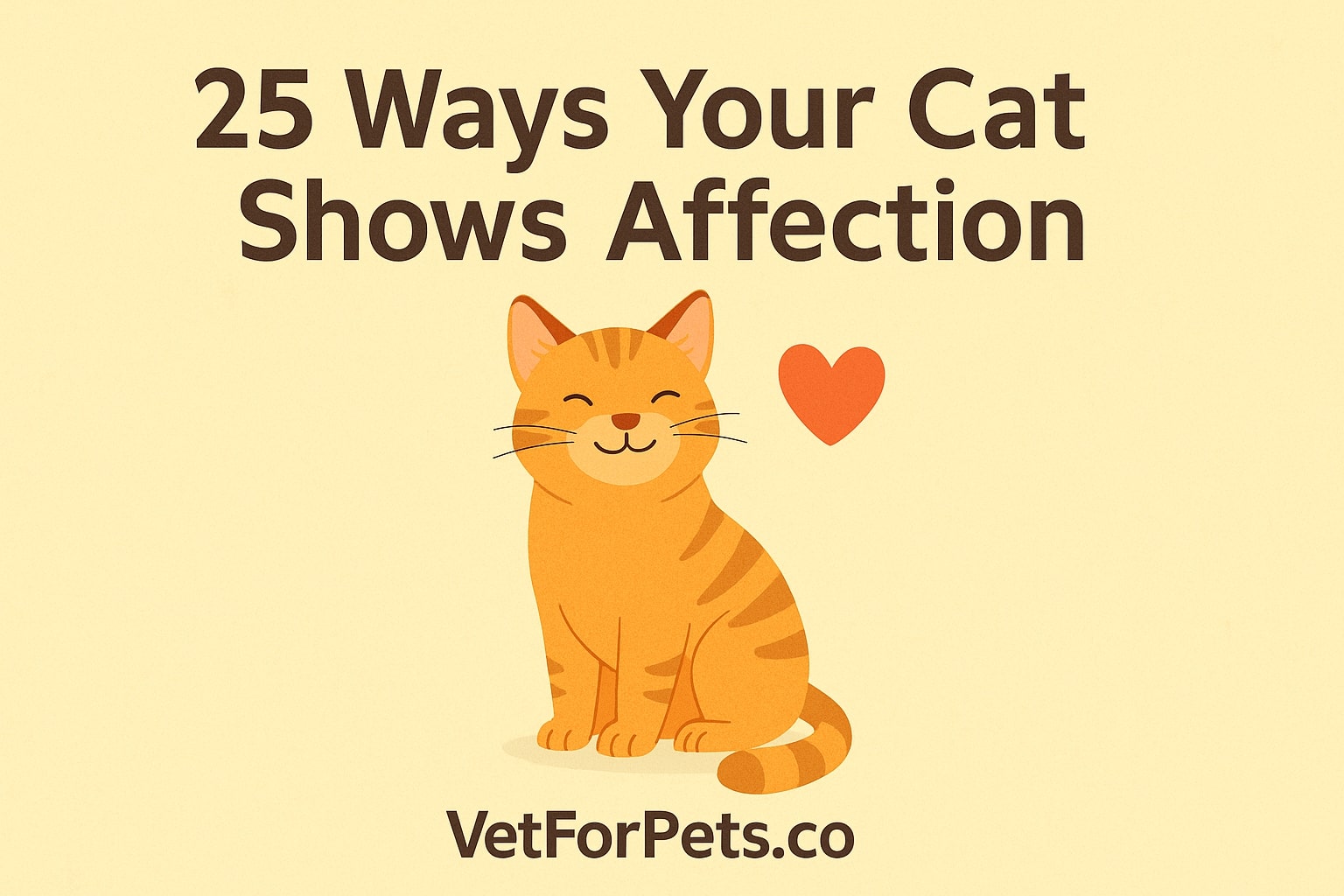Understanding whether your cat truly loves you can sometimes feel like deciphering an ancient code. Unlike dogs, who wear their hearts on their sleeves with enthusiastic tail wagging and slobbery kisses, cats express affection in more subtle, sophisticated ways.
However, once you learn to recognize these cat behaviors, you’ll discover that your feline companion has been showering you with love all along. From gentle headbutts to strategic gift-giving, cats display their affection through a complex language of gestures, sounds, and behaviors that reflect their deep emotional connection with their human families.
Physical Displays of Affection
1. Slow Blinking
One of the most endearing ways cats show love is through slow blinking. When your cat looks at you and slowly closes their eyes, they’re giving you what many call “cat kisses”3. This behavior demonstrates complete trust and contentment. Try slow blinking back at your cat to return this affectionate gesture. Unlike direct staring, which cats can interpret as threatening, slow blinking with lowered lids expresses pure contentment and safety in your presence.
2. Headbutting and Bunting
When your cat gently bumps their head against you, they’re engaging in a behavior called bunting4. This affectionate gesture serves multiple purposes: it leaves their scent on you through pheromones and signals a friendly encounter. Cats only headbutt those they feel confident and happy around, making this behavior a clear indicator that your cat considers you part of their inner circle.
3. Showing Their Belly
Perhaps one of the most vulnerable displays of trust, a cat showing their belly demonstrates complete security in your presence. The belly area is particularly sensitive and vulnerable on a cat’s body, protected by what’s called a primordial pouch. When your cat exposes this area to you, they’re displaying ultimate trust and affection, though not all cats will do this even if they love you deeply.
4. Kneading
Often called “making biscuits” or “happy paws,” kneading is when cats flex and push their paws alternately against soft surfaces, including your skin. This behavior originates from kittenhood when kittens knead their mother’s abdomen to stimulate milk flow. When your adult cat kneads you, they’re treating you as a beloved family member and expressing contentment rooted in their earliest positive associations.
5. Grooming You
If your cat licks or grooms you, especially while you’re petting them, they’re showing remarkable affection. This behavior ties back to social grooming practiced by cat colonies as a means of bonding and reinforcing social relationships. Many experts suggest that your cat actually sees you as an oversized member of their feline family, and grooming you confirms your status as a beloved clan member.

Behavioral Expressions of Love
6. Following You Around
When your cat follows you from room to room, sometimes weaving between your legs as you walk, they’re demonstrating their desire to be involved in your daily activities. This behavior shows that cats who receive affection from their humans associate them with positive interactions and seek continued closeness.
7. Greeting You at the Door
A dog-like behavior that some cats adopt, greeting you enthusiastically at the door shows pure joy that their favorite human has returned home. This behavior demonstrates how much your presence means to your cat and their eagerness to reconnect with you after any separation.
8. Sleeping On or Near You
When cats choose to sleep on you or nearby, they’re making themselves vulnerable in your presence. As natural hunters, cats remain wary of threats even while resting. By sleeping on or near you, they’re showing complete trust and security. Even cats who aren’t typically affectionate will often sleep near their humans when they feel safest.
9. Bringing You Gifts
While finding a dead mouse or bird at your feet might not feel like a present, gift-giving is actually a significant expression of feline love. Cats bring their humans these “treasures” as offerings, sharing their hunting success with their beloved family members. This behavior demonstrates that your cat wants to provide for you and include you in their natural behaviors.
10. Cuddling
Whether your cat is a true lap cat or prefers sitting beside you for pets, all forms of cuddling represent genuine affection. Some cats are naturally more physically affectionate than others, but any willingness to engage in close physical contact shows trust and love.
Vocal Communications of Affection
11. Meowing
Adult cats primarily meow to communicate with humans rather than other cats. When your cat meows at you (outside of expressing hunger, medical issues, or stress), they’re essentially saying “love me” and seeking interaction with their favorite person. Many cats learn that meowing triggers positive responses from their humans, reinforcing this loving communication.
12. Purring
The classic sound of contentment, purring, often accompanies other affectionate behaviors. While cats sometimes purr when stressed or unwell, purring in relaxed settings while being petted or cuddled represents genuine happiness and love.
13. Trilling and Chirping
Some cats communicate through trilling sounds or chirps, especially when greeting their humans. These vocalizations represent friendly communication and excitement about interacting with you.
Postural and Movement Signs
14. Tail Language
A cat’s tail tells a story of their emotional state. When feeling particularly happy and loving, cats hold their tails high in the air with a confident posture. The tip might crook forward or quiver with excitement. Some cats even wrap their tails around their human’s leg as a friendly greeting, much like holding hands.
15. Standing and Approaching
Simple behaviors like standing up when you enter the room or actively approaching you demonstrate interest and affection. These distance-reducing behaviors show your cat’s desire to be closer to you and engage in social contact.
16. Reaching Out
When cats reach toward you with their paws, they’re actively seeking contact and connection. This gesture shows they want to bridge the physical gap between you and initiate interaction.
Trust-Based Behaviors
17. Eye Contact
While direct staring can be threatening between cats and strangers, comfortable eye contact with their humans shows complete acceptance. Cats who are happy to look you in the eye, especially while slow blinking, have lovingly accepted you as one of their own.
18. Presenting Their Behind
Though it might seem like a backhanded compliment, when cats present their rear end to you, they’re actually offering a very personal greeting. Cats identify each other by scent, and this behavior is equivalent to an intimate handshake, signaling that you’re one of their most trusted people.
19. Playing
Engaging in play with you demonstrates comfort and happiness in your presence. Cats who initiate play or respond enthusiastically to your play attempts are expressing joy in your company and trust in your intentions.
20. Touching and Rubbing
When cats rub against you or initiate physical contact, they’re marking you with their scent while simultaneously seeking affection. This behavior reinforces social bonds and claims you as their own.
Interactive Affection Signs
21. Gentle Biting
Playful, gentle biting mimics how kittens show affection to each other. If your cat gives you soft bites that don’t hurt, they’re expressing love through kitten-like behavior. However, if the bites become too hard, redirect their attention with toys rather than reacting negatively.
22. Sniffing
Cats gather information about their world through scent, and when they sniff you, they’re learning about your day and reinforcing their connection with you. This investigative behavior shows interest and care about your experiences.
23. Yawning in Your Presence
Yawning around you indicates complete relaxation and comfort. When cats feel safe enough to let their guard down completely, it demonstrates deep trust in your protective presence.
24. Grooming Themselves Near You
When cats engage in personal grooming while in your vicinity, they’re demonstrating that they feel secure and relaxed around you. This behavior shows they consider your presence calming rather than stressful.
25. Staying at the Front of Their Space
Whether in a cage, room, or their favorite spot, cats who position themselves at the front when you approach are actively seeking interaction. This forward positioning demonstrates eagerness to engage with you rather than hiding or avoiding contact.
Conclusion
Recognizing these 25 signs of feline affection can transform your relationship with your cat and deepen your understanding of their emotional world. While cats may not express love in the same obvious ways as dogs, their affection runs just as deep and genuine. Each cat has their own personality and preferred methods of showing love, so your feline friend might display some of these behaviors more than others.
The key to appreciating your cat’s love lies in observing their individual patterns and recognizing that even the most independent cats have their own special ways of saying “I love you.” From the subtle slow blink across the room to the more obvious lap-sitting session, every gesture represents a choice your cat makes to include you in their world.
By understanding and responding to these signs appropriately, you can strengthen the bond with your feline companion and enjoy a richer, more connected relationship built on mutual trust and affection.
Remember that building a loving relationship with your cat takes time and patience. Some cats are naturally more demonstrative than others, and factors like age, personality, and past experiences all influence how cats express their emotions.
The most important thing is to appreciate whatever level of affection your cat offers and respond with gentle, consistent care that makes them feel secure and loved in return.
- Parrotlets (Personality, Care, Health, Nutrition, & Cost) - June 20, 2025
- Caique (Personality, Care, Health, & Nutrition) - June 20, 2025
- The Complete Guide to Golden Retrievers - June 9, 2025















